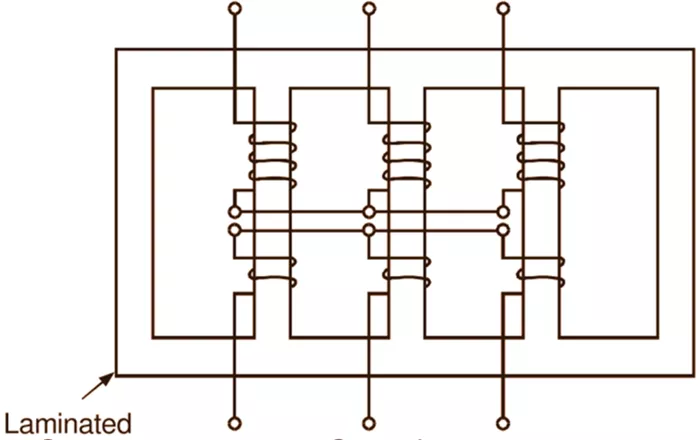Three phase transformers are essential components in modern electrical systems, designed to efficiently transform electrical energy between different voltage levels in three-phase power systems. These transformers play a crucial role in power generation, transmission, and distribution, ensuring that electrical energy is delivered reliably and efficiently to various applications. Understanding the principles, construction, and applications of three phase transformers is vital for anyone involved in electrical engineering and power systems.
Three phase transformers are widely used due to their ability to handle large loads and provide balanced power distribution. They are more efficient and compact compared to single-phase transformers, making them ideal for industrial, commercial, and large-scale residential applications. These transformers can step up or step down voltage levels, which is essential for efficient long-distance power transmission and for adapting to the specific voltage requirements of different equipment.
Basic Principles of Three Phase Transformers
Electromagnetic Induction
The operation of a three phase transformer is based on the principle of electromagnetic induction. When an alternating current (AC) flows through the primary winding, it generates a changing magnetic field in the core. This changing magnetic field induces a voltage in the secondary winding, allowing the transformer to transfer electrical energy between circuits.
Three Phase System
A three phase system consists of three alternating currents, each phase-shifted by 120 degrees. This configuration allows for more efficient power transmission compared to single-phase systems. The balanced load distribution in a three phase system reduces the risk of overloading and improves overall system efficiency.
Transformer Ratios
The voltage transformation ratio in a three phase transformer is determined by the number of turns in the primary and secondary windings. A step-up transformer increases the voltage level, while a step-down transformer decreases it. This capability is crucial for matching the voltage levels required by different parts of the power system.
Construction of Three Phase Transformers
Windings
Three phase transformers have three sets of primary and secondary windings, each corresponding to one phase of the three-phase system. These windings are typically made from copper or aluminum and are insulated to prevent electrical short circuits.
Core
The core of a three phase transformer is usually made from laminated silicon steel. Laminations help reduce eddy current losses, which are unwanted circular currents induced in the core material by the changing magnetic field. The core provides a low-reluctance path for the magnetic flux, ensuring efficient operation.
Types of Three Phase Transformers
Core Type
In a core-type three phase transformer, the primary and secondary windings are placed within the same core limbs. Each limb has two sets of windings, with the low voltage (LV) winding typically wrapped around the high voltage (HV) winding. This configuration allows for efficient magnetic coupling and power transfer.
Shell Type
Shell-type three phase transformers consist of three separate single-phase transformers, each with its own magnetic field. The core is five-limbed, with the high voltage and low voltage windings placed around the three main limbs. The outermost limbs serve as flux return paths.
Applications of Three Phase Transformers
Power Generation
Three phase transformers are used to step up the voltage from generators to levels suitable for long-distance transmission. This reduces power losses due to resistance in the transmission lines.
Transmission and Distribution Networks
In transmission and distribution networks, three phase transformers match voltages between substations, distribution lines, and consumer levels. They ensure efficient power delivery and voltage regulation.
Industrial Applications
Three phase transformers support large industrial motors, variable speed drives, and welding systems. They provide the necessary voltage levels for efficient operation and ensure reliable power supply.
Commercial Facilities
Commercial buildings, shopping malls, and office complexes often require three-phase power for their electrical systems. Three phase transformers ensure that these facilities receive stable and efficient power supply.
Transportation Systems
Three phase transformers are also used in transportation systems, such as railways, metros, and electric vehicle charging infrastructure. They provide the necessary power for these systems, ensuring reliable operation.
Advantages of Three Phase Transformers
High Efficiency
Three phase transformers are designed to operate with high efficiency, minimizing energy losses. Their construction with laminated cores and insulated windings ensures that they can transfer electrical energy with minimal losses.
Compact Design
Compared to single-phase transformers, three phase transformers are more compact and economical. They can handle larger loads and provide balanced power distribution, making them ideal for various applications.
Reliability
Three phase transformers are known for their reliability and durability. They can withstand harsh operating conditions and provide consistent performance over long periods.
Flexibility
Three phase transformers can be configured in various ways to meet specific application requirements. Common configurations include delta-delta (Δ-Δ), wye-wye (Y-Y), delta-wye (Δ-Y), and wye-delta (Y-Δ) connections.
Conclusion
Three phase transformers are fundamental components in modern electrical systems, providing efficient voltage transformation and power distribution. Their ability to handle large loads, provide balanced power distribution, and operate with high efficiency makes them essential for various applications, from power generation to commercial and industrial use. By understanding the principles, construction, and applications of three phase transformers, engineers and technicians can better integrate these devices into their systems, ensuring optimal performance and reliability.
Related Topics:

